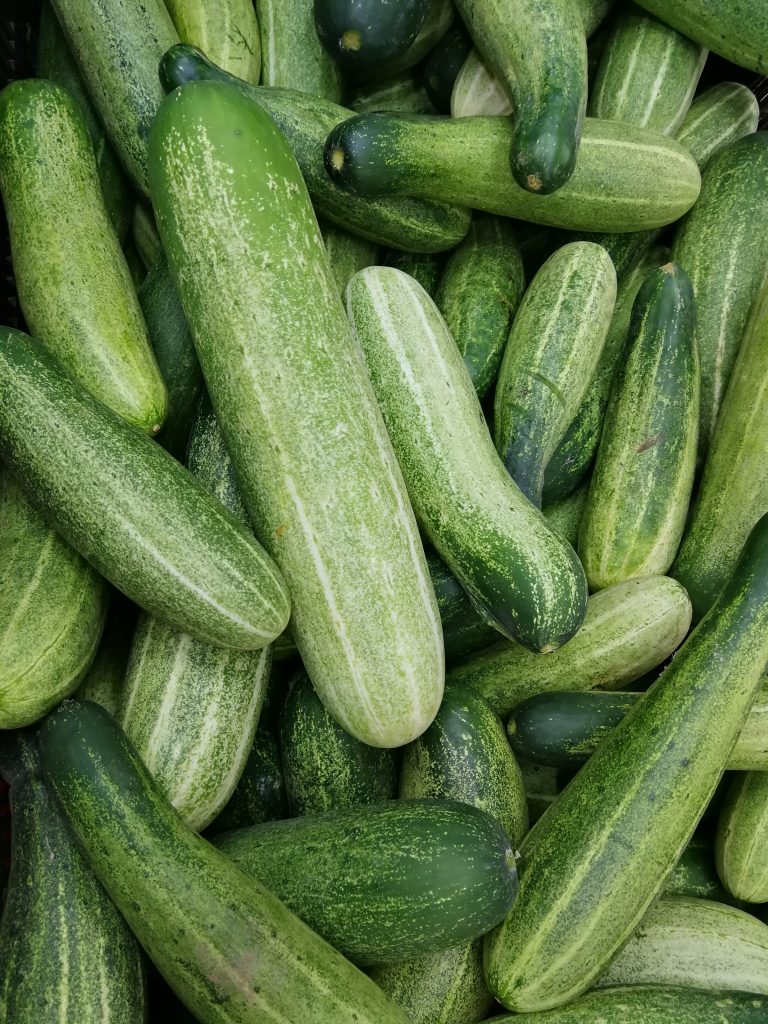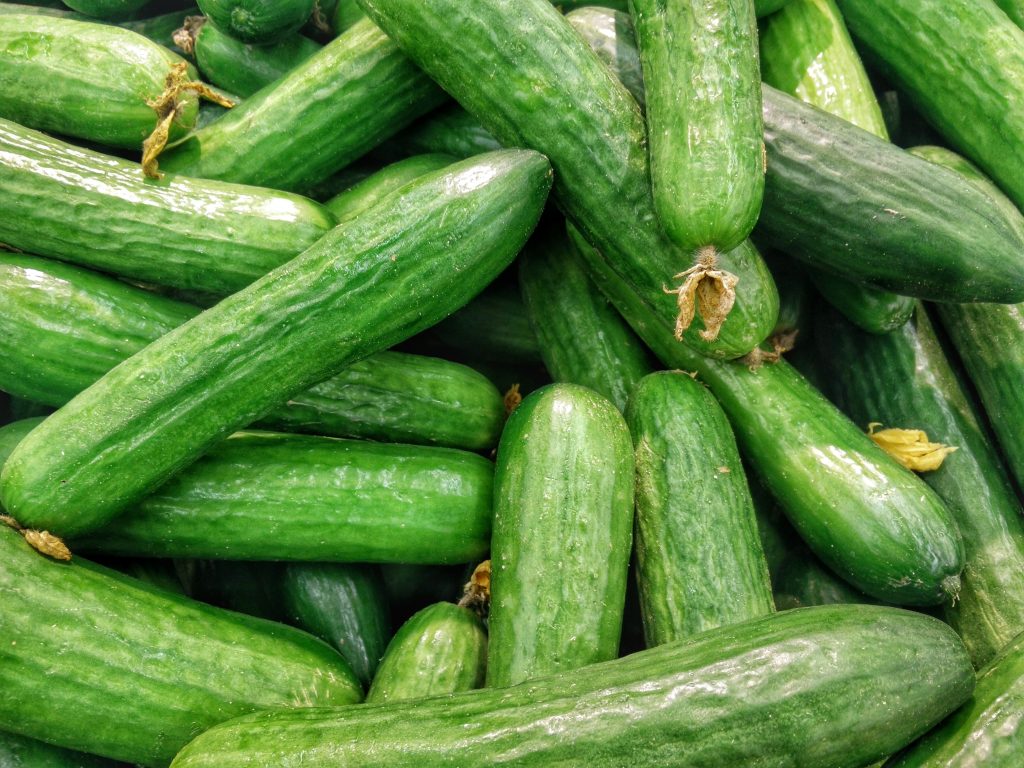Square foot gardening divides a growing space into small square parts that usually are one foot (30 cm) on each side, hence the term “square foot gardening.” Square foot gardening is a quick and easy way to get a new garden up and running, making it ideal for first-time gardeners.
There is no unused space between rows because there are no paths between them. The outcome of this intensive planting is a more significant return from your square foot garden than you would get from a standard garden space.
This improves the circulation of the cucumber plants, keeps them off the soil, and makes harvesting the cucumbers easier. Cucumbers are best grown in square footbeds with fresh, nourishing soil, which allows you to put them closer together.
Square foot gardening consists of a garden bed with dimensions of 4 feet by 4 feet and a depth ranging from 6 to 12 inches. A light-weighted, nutrient-dense soil mix in the bed serves as a foundation for Cucumber plants’ development.
Watering and harvesting are concentrated in a single, easily accessible location, which reduces the time spent on each task. You can readily cultivate two cucumber plants per square foot using square foot gardening techniques.
Now you might be very excited to learn how to plant my Cucumber in a square foot garden, then read our today’s article. Because in this article, we will show you the process of planting Cucumbers in a square-foot garden in an easy way.

The Accessories That Should You Gather
- The chicken wire makes an excellent fence for your square foot garden and yard. It will keep rabbits, deer, chickens, and cats, among other animals. Making a ‘cage’ around your plants using chicken wire is quick and straightforward, and it will keep your plants secure from being eaten by your chickens, deer, bunnies, squirrels, birds, and rodents, among other animals.
- Gardening year-round in the Growing Dome is possible, allowing you to grow your fresh organic produce free of pesticides and toxins. Using a Growing Dome, you can be confident about what you are consuming while also relaxing and taking advantage of the numerous health advantages that such bright plants bring.
- Cucumbers that grow on vines do best when they have support. A trellis in a tent saves room in the garden while also elevating the fruit off the ground, keeping it cleaner and more fresh. The cucumber vine’s tendrils will catch on the wires and anchor it to the trellis as it develops.
How To Plant Cucumber In Square Foot Garden
Step 1: Ensure the Right Location
Cucumbers grow best in loose sandy loam soil, although they can be grown in well-drained soil with good drainage. Before planting, incorporate compost or aged manure into the soil to 2 inches and work it into the soil 6 to 8 inches below. It is essential to ensure that the soil is moist and well-drained rather than waterlogged and compacted.
The pH of the soil should be neutral or slightly acidic, ranging between 6.5 and 7.0. Cucumbers thrive best when they are planted in full sunlight. Producing a poor fruit set and a reduced overall yield are two qualities of cucumber plants that receive little sunshine.
Therefore, it is recommended that they need to be planted in regions that receive at least 8 hours of direct sunlight each day. On the other hand, because their roots can reach depths of 36 to 48 inches, they should not be planted in areas where tree roots will suffocate them and rob them of water and nutrients.
The last and most important thing, cucumber plants demand continuous attention and monitoring; as a result, try to choose a place close to your home.
Step 2: Build The Planting Bed
The square foot garden bed should be around 4×4 square feet in size. This measurement is that the average person’s arm can extend at least 2ft from their body.
As a result, if you see a gardener with a raised bed that is 4 feet wide, you can be confident that the knowledgeable grower will always be able to reach the centre of their growing space. If you employ the square foot gardening method in a 4×4 foot raised garden bed, you can grow eight tomato plants and sixteen cucumber plants at the same time without straining your resources.
On the other hand, cucumber needs a lot of room to let its roots spread and receive nutrients from the surrounding soil. As a result, when preparing the soil, turn it over to a depth of 8 to 12 inches and incorporate fertiliser and organic matter into the mix. Improve native soil by incorporating several inches of aged compost or other organic materials rich in nutrients.
Make beds 4 to 6 inches high and at least 36 inches apart from one another out of the soil. Ridges are crucial in heavy soils and poorly drained places since cucumbers require sufficient drainage to grow successfully.
Step 3: Fill The Planting Bed With Soil
After ensuring the planting bed is in the right dimension, it’s time to fill your Cucumber planting bed with nutrients soil. A third of the bed should be filled with peat moss. Peat moss is highly effective in increasing soil water retention, and it can hold up to 20 times its weight in water.
On the other hand, it effectively retains nutrients in the soil and serves as a good supply of organic matter, which will slowly break down over a year or two to provide nutrients to the soil.
Second, one-third of the bed should be filled with vermiculite. Vermiculite helps to aerate the soil while also retaining water and nutrients, which it then releases over time as the soil becomes more aerated. The mining of natural resources obtains it.
The roots of cucumbers require a good supply of air, and water alone will not suffice to provide this supply, making vermiculite an excellent addition to the soil.
Third, a third of the bed should be filled with multipurpose compost to provide additional nutrients. Enhanced root growth and a reduction in root infections were achieved with multipurpose compost, resulting in improved plant survival and growth and improved plant quality.
It decreased nutrient leaching while simultaneously increasing nutrient levels, reducing the demand for expensive fertilisers. If you want to make your compost, you can use organic matter from your backyard and kitchen waste or purchase it from a garden centre.

Step 4: Plant The Cucumbers
When using square foot gardening techniques, cucumber plants should be spaced out at two per square foot. When planting, keep in mind that the two plants should be placed 6 inches apart to allow proper growth.
It allows your cucumbers to grow larger while also decreasing their susceptibility to disease and other factors such as competition. When planting, make an effort to keep the plants in the centre of the bed.
You can also mark the centre of the square and plant one plant 3 inches right of the centre and another 3 inches left of the centre to ensure that the two cucumbers are correctly spaced apart for growth, which should be 6 inches for each cucumber.
Step 5: Add Tent-Type Trellis
Cucumbers grow best when they can climb rather than being spread out on the ground. The vines’ tendrils will catch hold of fences, string, wire trellis, or towering cages, allowing them to climb the structures.
Also, cucumbers produce more fruit than shrub kinds, but they demand a bigger growing space than bush forms of cucumbers. Using a trellis to support cucumber plants allows for better air circulation and reduces the spread of foliar diseases such as powdery mildew, which can cause leaf drops.
Most people choose to use tent-shaped trellises because they conserve room in the garden while raising the fruit off the ground, remaining clean and fresher longer. The cucumber vine’s tendrils will catch on the wires and anchor it to the trellis as it develops.
Lastly, remember to construct the trellis on the northern side of the bed so that all plants receive the maximum amount of sunlight.
Caring Tips Of Cucumbers In Square Foot Garden
To keep your Cucumbers healthy after planting them, you follow some caring tips regularly. Continue reading for three pieces of advice on caring for your Cucumbers to help you achieve a good harvest with your plant.
Water Properly
Cucumbers will grow appropriately if they are not given proper care. Make sure that they receive an inch of water per week if possible. Cucumbers are fast-growing plants that require between 1 and 2 inches of water per week, depending on the weather and the type of soil used.
The goal is to maintain a minor moisture level in the soil. However, we urge that you water the plant when the soil is arid. The finger test is the quickest and most accurate method of determining whether or not a plant is ready to be watered.
If you notice an inch or more of soil has dried out, water it in, but avoid overwatering. Make the most of your food-growing efforts, on the other hand, by regularly feeding plants with a portion of water-soluble plant food.
On the other hand, try to water your cucumbers first thing in the morning because the sun will evaporate any surplus water after being watered in the morning. However, if you plant your cucumbers in the evening, excess moisture will stay, and your plants may become infected with a fungal disease.

Mulch Around Your Cucumber
Adding ‘mulch’ around cucumber plants can help to guarantee that soil moisture remains consistent throughout the growing season. Mulching is essential for reducing moisture loss from the soil and controlling weeds in the landscape.
Mulching helps to keep soil from being degraded by the sun. Mulch is a layer of material placed on top of the soil to protect it from the elements, such as compost, straw, dried leaves or shredded newspaper.
To prevent excessive evaporation from the soil around your cucumber plants, add a layer of mulch 1 inch thick on top of the soil.
Treat The Diseases
Bacterial wilt, powdery mildew, and downy mildew are all diseases that harm the leaves of plants. A variety of diseases such as anthracnose, leaf spot, and blight can cause the leaves of cucumber plants to become brown and die.
Gardeners should follow the necessary hygiene standards to avoid disease that results in browning and withering leaves. If you detect any of your cucumber plants have been infected, remove and destroy the infected plants as soon as possible.
Next year, concentrate on preventing it by planting only disease-resistant types with FW’s disease-resistance code on their seed packets. Soil solarisation can aid in the destruction of spores in the soil’s top few inches.
FAQ
What is the best time of year to plant cucumbers?
Cucumbers should be planted outside once the earth has warmed up, occurring in late spring or early summer. Plants should be gradually acclimated for a week or two before the event. A cold frame is beneficial during this stage of hardening off. You can put seeds directly into their ultimate growing places in warmer climates, saving time and effort.
What temperature is too cold for cucumbers?
Cucumbers (Cucumis sativus) are sensitive annuals that flourish in temperatures ranging from 65 to 75 degrees Fahrenheit. Cucumbers (Cucumis sativus) are members of the cucumber family (18-23 C.). Extended exposure to temperatures below 55 degrees Fahrenheit can be hazardous.
How do I protect my cucumber plants from bugs?
Cucumber plants benefit from being elevated to protect their leaves and vines from being eaten by insects. Plant herbs and flowers around your tomato and cucumber plants to provide colour and fragrance to the environment. Basil effectively repels whiteflies, damaging tomato plants, and oregano is effective in protecting tomato and cucumber plants.
What should be planted after cucumbers?
When your companion plant the same plants beside your cucumbers, you will be able to rotate them together year after year. With cucumber plants, root vegetables such as onions, carrots and radishes do well since they have a similar root structure.
Final Thought
Cucumbers can be grown in a square-foot garden using these methods.
Cucumbers grow long, slender fruits that can measure anywhere from 3 to 24 inches in length when adequately cared for and disease-free. 50 to 70 days after planting, depending on how you intend to utilise them.
Leave a comment below if you have any further questions concerning today’s article. We will do our best to get back to you as soon as possible with an answer.
Do your best!


